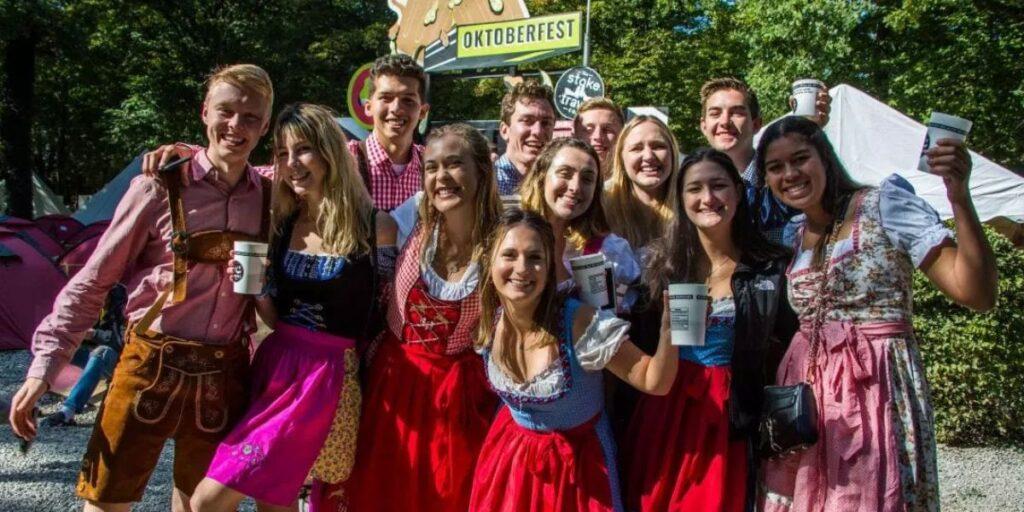Handmade Traditional Bavarian Dirndl Dresses: A Timeless Emblem of Culture and Craftsmanship
The allure of handmade Traditional Bavarian Dirndl dresses lies in their intricate craftsmanship, rich history, and enduring cultural significance. As we step into 2025, these iconic garments continue to captivate fashion enthusiasts and cultural aficionados alike. Whether worn during Oktoberfest, weddings, or festive gatherings, a genuine Bavarian Dirndl embodies elegance, tradition, and artisanal mastery. In this guide, we delve into the world of handmade Dirndl dresses, exploring their origins, modern adaptations, styling tips, and where to find authentic pieces in 2025.

The History of Bavarian Dirndl Dresses: Handmade Traditional Bavarian Dirndl Dresses
Origins in Alpine Tradition
The Dirndl originated in the 19th century as a practical garment for Alpine farmers and servants in Bavaria, Austria, and South Tyrol. Its name derives from the German word “Dirn” (meaning “young woman”), reflecting its role as everyday wear for working-class women. Over time, the Dirndl evolved into a symbol of regional pride, often adorned with embroidered motifs, lace trims, and vibrant fabrics.
Evolution into Festive Attire
By the early 20th century, the Dirndl transitioned from workwear to festive attire. The rise of Oktoberfest in Munich cemented its status as a cultural icon. Today, wearing a Dirndl is a celebration of Bavarian heritage, with each element—the bodice, blouse, skirt, and apron—carrying symbolic meaning.
What Makes a Handmade Traditional Dirndl Unique?
Artisanal Craftsmanship
Unlike mass-produced alternatives, handmade Traditional Bavarian Dirndl dresses are crafted by skilled artisans who preserve centuries-old techniques. Key features include:
- Custom Tailoring: Each dress is tailored to fit the wearer’s measurements perfectly.
- High-Quality Materials: Linen, cotton, and wool are paired with silk ribbons and hand-stitched embroidery.
- Symbolic Details: Apron bows (positioned left, right, or center) traditionally indicate marital status.
Sustainability in 2025
Modern consumers prioritize sustainability, and handmade Dirndls align with this ethos. Artisans increasingly use eco-friendly dyes, organic fabrics, and zero-waste patterns, making these dresses a choice for ethically minded buyers.
2025 Trends in Bavarian Dirndl Fashion
Modern Meets Traditional
While authenticity remains paramount, 2025 sees innovative twists:
- Bold Colors: Deep emerald, cobalt blue, and ruby red replace classic pastels.
- Mixed Textures: Velvet bodices paired with lace blouses add depth.
- Minimalist Designs: Simplified embroidery appeals to contemporary tastes.
Customization and Personalization
Buyers now seek bespoke Dirndls featuring:
- Monogrammed aprons.
- Family crest embroidery.
- Adjustable waistbands for versatility.
How to Choose the Perfect Handmade Dirndl
Consider the Occasion
- Oktoberfest: Opt for vibrant colors and bold patterns.
- Weddings: Choose ivory or pastel hues with delicate lace.
- Casual Events: Lightweight cotton Dirndls with shorter skirts.
Fit and Comfort
Ensure the bodice snugly supports without restricting movement. Look for adjustable straps and breathable fabrics.
Authenticity Check
Verify craftsmanship by:
- Checking for hand-stitched seams.
- Asking about the artisan’s background.
- Confirming the use of natural materials.
Where to Buy Authentic Handmade Dirndls in 2025
Boutique Ateliers in Bavaria
Visit workshops in Munich, Garmisch-Partenkirchen, or Murnau for in-person fittings and custom designs.
Online Marketplaces
Reputable platforms like Etsy and Dirndlsonline.com connect buyers with certified artisans. Look for shops with 5-star reviews and detailed product descriptions.
Sustainable Brands
Brands like Dirdlmacherei and Trachten-Volk blend tradition with eco-conscious practices, offering vegan leather aprons and organic cotton blends.
Caring for Your Handmade Dirndl
Washing Tips
- Spot Clean Only: Handwash delicate embroidery with mild soap.
- Air Dry Flat: Avoid sunlight to prevent fading.
Storage Advice
- Use padded hangers to maintain the bodice shape.
- Store in a breathable garment bag to protect from dust.
The Cultural Impact of Dirndls in 2025
Beyond fashion, Dirndls symbolize Bavarian identity. In 2025, cultural initiatives promote Dirndl-making workshops and heritage festivals, ensuring younger generations appreciate this craft. Social media influencers and celebrities, like Lena Meyer-Landrut, have also reignited global interest by pairing Dirndls with modern accessories.
FAQs About Handmade Traditional Bavarian Dirndl Dresses
1. What is the significance of the apron bow placement on a Bavarian Dirndl?
The apron bow’s position traditionally indicates marital status: left (single), right (married/engaged), center (widowed), and back (waitstaff). This subtle detail adds cultural depth to the Dirndl’s design.
2. How do I determine the correct size for a handmade Dirndl?
Handmade Dirndls are often custom-tailored. Provide your bust, waist, and hip measurements to the artisan. Many ateliers offer adjustable straps and waistbands for a personalized fit.
3. Are modern Dirndls suitable for everyday wear?
Yes! Lightweight cotton or linen Dirndls with shorter skirts are designed for casual events, while ornate styles with silk or velvet are ideal for festivals or weddings.
4. What materials are used in authentic handmade Bavarian Dirndls?
Artisans use natural fabrics like wool, cotton, and linen, paired with silk ribbons, lace, and hand-embroidered motifs. Sustainable brands in 2025 also incorporate organic and recycled materials.
5. Can I customize my Dirndl with unique embroidery?
Absolutely. Many artisans offer bespoke designs, such as monograms, floral patterns, or family crests, to create a one-of-a-kind piece.
6. How do I verify the authenticity of a handmade Dirndl?
Check for hand-stitched seams, natural fabrics, and artisan certifications. Reputable sellers provide details about the maker’s background and traditional techniques used.
7. Are there vegan-friendly Dirndl options available?
Yes! Brands like Dirdlmacherei now offer vegan Dirndls with synthetic silk, cruelty-free dyes, and faux leather aprons to cater to ethical shoppers.
8. How long does it take to craft a handmade Dirndl?
Depending on complexity, it can take 4–8 weeks. Custom designs or intricate embroidery may require additional time to ensure quality craftsmanship.
9. Can I wear a Dirndl in colder weather?
Opt for woolen Dirndls with long sleeves or layer with a tailored Trachten jacket. Some designs include detachable faux-fur shawls for warmth.
10. What accessories complete a traditional Dirndl look?
Pair your Dirndl with a lace blouse, embroidered handbag, T-bar shoes, and silver jewelry. In 2025, trendy additions include minimalist hairpins and embroidered face masks.
Conclusion: Handmade Traditional Bavarian Dirndl Dresses
In 2025, handmade Traditional Bavarian Dirndl dresses remain a testament to artistry and cultural pride. Whether you’re dancing at Oktoberfest or honoring your heritage, investing in an authentic Dirndl ensures you wear a piece of history. By supporting artisans and choosing sustainable options, you contribute to preserving this timeless craft for future generations
